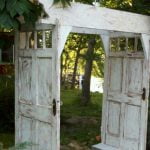Looking for quirky ideas for small gardens? In this article, we’ll explore the charm of small gardens and the potential for creativity in limited space. Small gardens may seem challenging to work with, but they offer a unique opportunity to think outside the box and create something truly special. From container gardening to vertical gardening, edible landscaping to fairy gardens, there are countless ways to make the most of a small outdoor space.
When it comes to small gardens, creativity knows no bounds. With unique and unconventional containers for plants, maximizing space is easier than you might think. Vertical gardening also offers an innovative approach to utilizing walls and structures for growing plants in a small garden.
By incorporating edible plants and herbs into the landscape, you not only add practicality but also a touch of beauty. And who wouldn’t love the idea of creating a whimsical and enchanting mini garden with delicate flowers and miniature accessories?
In this article, we’ll delve into various quirky ideas for small gardens that can transform any limited outdoor space into a lush and vibrant oasis. Whether you’re interested in low-maintenance succulents or upcycled garden decor, there’s something for every taste and style. So let’s embrace our small garden’s potential for uniqueness and individuality as we embark on this creative journey together.
Container Gardening
One quirky idea for small gardens is to use old furniture such as wooden chairs or a vintage suitcase as planters. This not only adds a touch of personality to your garden but also gives new life to items that might have otherwise been discarded. Another fun idea is to use mason jars or tin cans as hanging planters, creating a charming and rustic look in your small garden.
In addition, using vertical space can further maximize the potential for container gardening in small gardens. Hanging baskets, wall-mounted planters, and tiered shelves can all be used to add an extra dimension to the garden and make use of every available inch of space. With a little creativity and resourcefulness, container gardening can turn even the tiniest of outdoor spaces into a lush and vibrant oasis.
By embracing container gardening and thinking outside the box (or pot), individuals can transform their small gardens into unique and captivating havens that reflect their personal style and creativity. Whether it’s using unconventional containers, incorporating vertical elements, or repurposing everyday items, container gardening offers endless opportunities for expressing individuality in small garden spaces.
Vertical Gardening
Maximizing Space With Vertical Planters
Vertical gardening is a game-changer for small garden owners. By utilizing walls, fences, and even structures like trellises, gardeners can make the most of their limited space. One quirky idea for vertical gardening is to use unconventional items as planters. Consider repurposing old rain gutters, shoe organizers, or even wooden pallets to create a unique vertical garden.
Climbing Plants and Vines
Another way to incorporate vertical gardening into a small garden is by choosing plants that naturally climb or vine. This not only adds visual interest but also makes efficient use of the vertical space. Some options include flowering vines like clematis or jasmine, or edible climbers like beans and peas. For a quirky twist, try training your climbing plants on whimsical-shaped wire frames to add an element of fun and creativity to your small garden.
The Power of Green Walls
Green walls, also known as living walls, are a stunning way to bring greenery into a small garden without sacrificing ground space. These vertical gardens are created by attaching pockets or containers to the wall and planting them with a variety of plants.
They not only serve as eye-catching features but also provide environmental benefits such as air purification and insulation. Get creative with the design by incorporating different textures and colors for an enticing and vibrant green wall in your small garden.
Edible Landscaping
In a small garden, every plant should serve a purpose, and what could be more satisfying than growing your own food? Edible landscaping is the perfect solution for small spaces, as it combines both aesthetic appeal and practicality. By incorporating edible plants and herbs into your small garden, you can create a beautiful landscape while also reaping the benefits of fresh, homegrown produce.
When planning your edible landscaping, consider mixing in vegetables such as colorful bell peppers, vibrant lettuces, and cherry tomatoes for pops of color. Herbs like basil, parsley, and rosemary also make excellent additions to any small garden, adding fragrance and flavor to your outdoor space. With some strategic planting and creativity in design, you can achieve a visually stunning garden that also serves as a mini kitchen garden.
In addition to the visual appeal of edible landscaping, there are numerous practical benefits. By growing your own fruits, vegetables, and herbs at home, you can save money on grocery bills while also ensuring that you have access to fresh and organic produce.
This approach also promotes sustainability and self-sufficiency by reducing the need for store-bought produce that is often shipped from far away. Embracing quirky ideas for small gardens like edible landscaping allows you to cultivate an outdoor space that not only looks beautiful but also provides tangible benefits for both you and your household.
| Small Garden Edibles | Benefits |
|---|---|
| Colorful Vegetables (bell peppers, lettuces) | Visual appeal; Homegrown produce |
| Herbs (basil, parsley) | Fragrance and flavor; Fresh ingredients |
Fairy Garden
The idea of creating a fairy garden in a small space is both charming and imaginative. This unique concept allows gardeners to embrace their creativity and incorporate delicate flowers and miniature accessories to create an enchanting mini garden. Whether you have a small backyard, balcony, or even just a tiny corner, the possibilities for developing a fairy garden are endless.
One of the key elements of a fairy garden is choosing the right plants. Delicate flowers such as Pixie Lilies, Miniature Roses, and Baby’s Tears add a whimsical touch to the garden while attracting butterflies and other pollinators. These plants can be complemented with tiny ferns, mosses, and low-growing ground covers to create a lush and magical setting for your fairy garden.
In addition to carefully selecting the right plants, incorporating miniature accessories is essential for bringing the fairy garden to life. Tiny fairy houses, miniature furniture, tiny bird baths, and decorative pebbles can be used to create an enchanting scene that will captivate both children and adults alike. For those who want an added touch of whimsy, consider adding tiny fairy lights or lanterns to illuminate the garden in the evening.
When it comes to designing a fairy garden in a small space, creativity knows no bounds. By utilizing containers such as old barrels or baskets, vertical structures like trellises or hanging planters, or even repurposed items like teacups or mason jars as planters, you can truly make your fairy garden stand out in any small space.
| Plants for Fairy Garden | Miniature Accessories |
|---|---|
| Pixie Lilies | Fairy houses |
| Miniature Roses | Miniature furniture |
| Baby’s Tears | Tiny bird baths |
Succulent and Cacti Garden
Succulents and cacti are ideal plants for small gardens due to their low-maintenance nature and unique appearance. They thrive in small spaces, making them the perfect choice for gardeners looking to add a touch of quirkiness to their outdoor oasis. These drought-resistant plants come in a variety of shapes, sizes, and colors, allowing for endless creativity when designing a succulent and cacti garden.
Choosing the Right Plants
When planning a succulent and cacti garden, it’s essential to select plants that will thrive in your specific climate and growing conditions. Some popular options for small gardens include Echeveria, Aloe Vera, Haworthia, and various types of Sedum. These plants require minimal watering and can often survive on neglect, making them perfect for busy individuals or those new to gardening.
Creative Display Ideas
One of the best parts about creating a succulent and cacti garden is the opportunity to get creative with how you display these quirky plants. Consider using unconventional containers such as vintage teacups, old mason jars, or even driftwood pieces to showcase your succulents. Additionally, vertical gardening techniques can be employed by planting succulents in wall-mounted planters or utilizing hanging baskets to maximize space in small gardens.
Maintenance Tips
Despite being low-maintenance overall, succulent and cacti gardens still require some care to thrive. These plants typically prefer well-draining soil, so be sure to use a specialized succulent mix or amend regular potting soil with sand or perlite. Additionally, provide adequate sunlight for your succulents-most varieties require at least six hours of sun per day. Lastly, while these plants are drought-tolerant, it’s crucial not to overwater them as this can lead to root rot.
Upcycled Garden Decor
Incorporating upcycled garden decor into a small garden is not only a great way to add character and charm, but it also promotes environmental consciousness and sustainability. By repurposing and reusing items that may have otherwise ended up in the landfill, you can create a quirky and unique aesthetic for your outdoor space. Here are some quirky ideas for small gardens that incorporate upcycled decor:
- Old Tires: Painted and stacked tires can be used as planters for flowers or herbs, adding a pop of color and whimsy to the garden.
- Broken Teacups and Saucers: Instead of disposing of chipped or cracked teacups, repurpose them as tiny planters for succulents or miniature flowers, creating an adorable tea party-inspired vignette.
- Vintage Windows and Doors: Salvaged windows and doors can be transformed into unique garden dividers or trellises for climbing plants, adding a touch of nostalgia to the space.
Additionally, incorporating items such as old bicycles, pallets, mason jars, and even mismatched kitchenware as planters or decorative elements can inject personality into a small garden while minimizing waste. Embracing these quirky ideas for small gardens not only adds visual interest but also aligns with eco-friendly practices.
Using upcycled garden decor allows you to infuse your outdoor space with creativity while reducing your carbon footprint. By thinking outside the box and seeing the potential in discarded items, you can create a truly one-of-a-kind garden that reflects your unique style and commitment to sustainability.
Zen Garden
Designing a Zen garden in a small outdoor space can create a peaceful and tranquil retreat. Utilizing the principles of Japanese rock gardens, these spaces are designed to cultivate mindfulness, relaxation, and balance. In a small garden, creating a Zen garden involves minimalist landscaping, carefully chosen elements, and thoughtful placement.
One approach to designing a Zen garden in a small space is to focus on simplicity. Use clean lines and minimalistic design to create an uncluttered and calming environment. Smooth gravel or sand can be raked in patterns to represent water or waves, while carefully placed rocks symbolize islands or mountains.
Another key element of a Zen garden is the use of natural materials. Consider incorporating bamboo fences or screens for privacy, as well as wooden benches or stepping stones. These elements not only add to the aesthetic of the garden but also contribute to the sense of tranquility and harmony within the space.
Additionally, integrating plants that hold spiritual significance in Japanese culture can enhance the ambiance of a Zen garden. For example, adding moss, bonsai trees, or flowering cherry blossoms can bring authenticity and beauty to the design. Whether you have limited outdoor space or simply prefer a more tranquil environment in your small garden, designing a Zen garden offers an opportunity for contemplation and relaxation amidst nature.
Conclusion
In conclusion, small gardens offer endless opportunities for creativity and innovation. From container gardening to vertical gardening, edible landscaping to whimsical fairy gardens, there are numerous quirky ideas for small gardens that can transform a limited space into a charming and unique outdoor oasis. By embracing unconventional and out-of-the-box approaches to gardening, individuals with small gardens can showcase their individuality and create a space that is truly their own.
It’s important for readers to remember that the size of a garden does not limit its potential for beauty and creativity. Incorporating quirky elements such as upcycled garden decor or designing a peaceful Zen garden can add character and charm to even the smallest outdoor spaces.
Embracing the uniqueness of a small garden allows individuals to personalize their outdoor area in a way that reflects their own interests and tastes, making it a special haven that brings joy and satisfaction.
So, whether it’s through cultivating an edible landscape or curating a collection of succulents and cacti, small garden owners should feel encouraged to experiment with unconventional ideas and designs. Each small garden has the potential to be a reflection of its owner’s personality, showcasing their individuality through innovative and quirky gardening practices.
The charm of small gardens lies in their ability to surprise and delight visitors, offering unique experiences in every nook and cranny. With open minds and creative spirits, anyone can turn their small garden into a one-of-a-kind space they can truly call their own.
Frequently Asked Questions
How Do You Create Interest in a Small Garden?
Creating interest in a small garden can be achieved by incorporating a variety of plants with different colors, textures, and heights. Adding features such as a small water feature, garden art, or unique potted plants can also bring visual appeal to the space.
How Can I Make My Garden More Fun?
Making your garden more fun can involve setting up an outdoor seating area for relaxation and enjoyment. Adding playful elements like a swing, hammock, or even a mini-garden for kids can make the space more engaging and enjoyable for everyone.
How Do You Entertain a Small Garden?
Entertaining a small garden can be done by hosting intimate gatherings or social events such as outdoor movie nights, picnics, or barbecues. Setting up cozy seating areas with outdoor lighting and music can also create a welcoming ambiance for guests to enjoy.

Welcome to my gardening blog! I am passionate about plants and enjoy sharing my knowledge and experiences with others. In this blog, I will write about everything related to gardening, from tips on how to get started to updates on my own garden projects.





